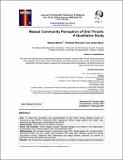Maasai Community Perception of Oral Thrush: A Qualitative Study

View/
Date
2015-02-03Author
Martin, Haikael
Petrucka, Pammla
Buza, Joram
Metadata
Show full item recordAbstract
Aim: To determine perception and understanding of oral thrush among Maasai women of reproductive age (WRA), Traditional Birth Attendants (TBAs), village leaders and health care
workers in the Ngorongoro Conservation Area (NCA).
Study Design: Cross sectional, qualitative research.
Place and Duration: Three villages namely; Olbalbal, Misigiyo and Alelilai in the Ngorongoro
Conservation Area, between March 2013 and September 2014.
Methodology: We included women of reproductive age (210), village leaders (5), Traditional Birth
Attendants (TBA) (13) and health care providers (18). Data was collected using focus group
discussions among Traditional Birth Attendants and village leaders, interview for women of reproductive age and health care providers.
Results: The community recognizes that oral thrush is a problem among pregnant and lactating
Maasai women. According to the Traditional Birth Attendants and village leaders, it is believed that oral thrush came with the modern use of western medication as opposed to their traditional
medications used earlier. They stated that their way of life has changed significantly causing these problems. Most WRA say oral thrush is a problem, but they do not know the cause. However, health care providers know that oral thrush is a problem with some knowing the causes and
associated risk factors in the Maasai community.
Conclusion: There appears to be an information gap between community members and healthcare providers with respect to the causes of oral thrush in women of child-bearing age in Ngorongoro Conservation Area. It is noted that TBAs are important to rectify this deficit, because if they understand the problem they can influence changes. Results from this research work can
inform more effective health promotion initiatives and interventions.
.
